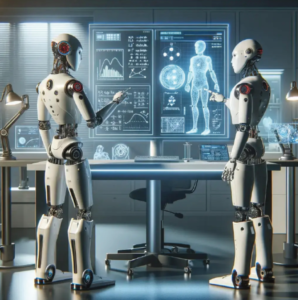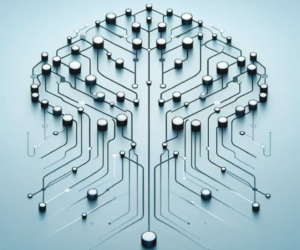An Innovative Approach to Transforming Healthcare Through Advanced Generative AI Technologies and Specialized Digital Twin Models
Summary
The healthcare industry, a data-rich and intricate field, constantly seeks innovation for enhanced patient care, accurate diagnostics, and streamlined administrative processes. The advent of Generative Artificial Intelligence (Gen AI), particularly powered by large language models like OpenAI’s GPT-4, introduces a groundbreaking technology poised to revolutionize healthcare.
In the face of vast and ever-growing textual data in healthcare, traditional methods such as keyword-based searches fall short of capturing the complexity of medical language. The challenge lies in extracting nuanced information from clinical notes, research papers, and patient histories. Additionally, while Language Models excel in pattern recognition, they often lack rigorous reasoning and explanation for their decisions.
This paper explores how GenAI can overcome the complications in healthcare data processing, ensuring a deep understanding of medical text and fostering efficient collaboration between language models and formal reasoning engines. Moreover, how can this technology be applied in Digital Twin Medical Centers to optimize patient care, automate tasks, and facilitate continuous improvement within a collaborative AI framework?
Deep Understanding of Text Using Embeddings
Text is transformed into numerical data or embeddings, ideal for algorithmic processing but not intuitive for human understanding.
The vast and ever-growing volume of textual data – clinical notes, research papers, and patient histories – in the healthcare industry presents both a challenge and an opportunity. To fully utilize this healthcare data rich with nuanced information requires deep understanding. Traditional keyword-based searches often fall short when dealing with the complexity and variability of medical language.
Gen AI can project medical text into a vector space with hundreds or thousands of dimensions. For example:
Original Text: “Patient exhibits symptoms of chronic migraine, including severe headaches and sensitivity to light.”
Resulting Embedding: [0.45, -0.67, 1.23, 0.88, …, -0.56] (a vector of numbers in a high-dimensional space).
Text is transformed into numerical data or embeddings, ideal for algorithmic processing but not intuitive for human understanding. In this space, the proximity between points (textual entries) reflects the semantic similarity far beyond what keyword matches can achieve. This allows for more nuanced searches where context, synonyms, and related concepts are considered.
Gen AI models have shown remarkable capability in understanding, contextualizing, and correlating complex medical text. By exploiting the benefits of embedding medical text data within high-dimensional spaces, we can understand the underlying semantics of text. This enables healthcare practitioners and researchers to benefit from sophisticated search and comparative analysis tools, ultimately leading to improved patient care and accelerated medical research.
The use of semantic embeddings in healthcare has multiple benefits:
Comparative Analysis: By considering text mapped to a high-dimensional space, patterns and relationships between different case notes or medical conditions can be identified, aiding in differential diagnosis or personalized medicine approaches. For example, the following two sentences differ significantly in structure and wording, yet their would be closely aligned, reflecting their similar meanings:
“The subject is suffering from sleep deprivation due to chronic nocturnal respiratory disturbances.”
“Chronic nighttime breathing disruptions are causing the individual to experience a lack of sleep.”
Enhanced Search Capabilities: Healthcare professionals can locate relevant studies and literature with a precision that mirrors human expert understanding but with the speed of an algorithm.
Knowledge Discovery: Semantic embeddings can reveal connections between disparate medical knowledge, leading to new insights and hypotheses.
To illustrate, consider the process of identifying similar clinical cases. A doctor treating a patient with a rare set of symptoms can use an LLM-powered tool to input the case notes into the system. The model then projects this input into the high-dimensional space and identifies other cases with closely situated points, indicating semantic similarity. This process can uncover valuable precedents for a more accurate diagnosis or treatment plan.
By harnessing the power of high-dimensional semantic embeddings, healthcare professionals are equipped with a level of data comprehension that was previously unattainable, promising advancements in patient outcomes and medical knowledge.
COMBINING GEN AI WITH OTHER TECHNOLOGIES
Language models excel at identifying general patterns and relationships in data, but they cannot often reason rigorously or explain their decisions. Symbolic deduction engines, on the other hand, are based on formal logic and use clear rules to arrive at conclusions. They are rational and explainable but can be “slow” and inflexible – especially when dealing with large, complex problems independently. Matching these two technologies together is akin to mimicking the concept of left brain and right brain. Gen AI can be paired with application-specific models to achieve impressive problem-solving for many new domains.
To create a healthcare companion to a medical specialist, we could imagine an AI agent that pairs the LLM with a Clinical Decision Support System (CDSS). A neural language model acts as the specialist’s scribe and librarian. It understands and processes the specialist’s spoken or typed language, extracting key information from patient interactions. This LLM handles the heavy lifting of documenting patient encounters, ordering lab tests, and retrieving patient histories, thereby reducing the specialist’s clerical burden.
Complementing the LLM is the CDSS, which serves as the analytical and rational counterpart. This system is embedded with medical algorithms, evidence-based rules, and a vast repository of medical knowledge. When the LLM captures the nuances of a patient’s condition, the CDSS kicks in to interpret clinical data, evaluate it against the latest medical guidelines, and even provide draft recommendations for the most effective diagnostic and treatment plans.
For example, when a patient showing signs of heart failure visits the cardiologist, the LLM component would swiftly organize the patient’s verbal and written information into a coherent medical profile. The CDSS would then cross-reference this profile with cardiologic databases, patient records, and treatment guidelines to propose a personalized draft care plan, ready for the cardiologist to finalize.
The LLM and CDSS duo thus enables the medical specialist to act quickly and precisely. The LLM ensures that all necessary information is accurately captured and easily accessible. At the same time, the CDSS guarantees that the specialist’s decisions are informed by a deep, data-driven understanding of medicine. The result is a dynamic duo that empowers specialists to spend less time on paperwork and more on what they do best – caring for patients.
Specialized AI Agents in Digital Twin Medical
The “digital twin” model represents our innovative use of LLMs as dynamic agents
These digital entities can mimic patient interactions or automate certain hospital operations, thus providing a safe and efficient environment for managing workflows and training medical professionals. A more comprehensive “digital twin” of a medical center revolves around creating an integrated system of specialized AI agents, each designed to handle specific sub-problems. These agents perform tasks independently and work in concert, evaluating and improving each other’s work. Here’s how such a system could be structured:
Specialization: Each agent is tailored to excel at a particular task. For example, one agent could be trained on medical literature to answer questions about drug interactions, while another might be optimized for scheduling using hospital data. Recognizing that each medical specialty has unique challenges, we can fine-tune LLMs to provide task-specific support that enhances the practitioner’s work to improve accuracy for specialized tasks.
Chaining: Agents can be sequenced to perform complex tasks. An agent that processes patient data can pass its findings to another specializing in diagnosis, which could trigger a treatment planning agent.
Interfacing with Non-LLM Technologies: Some agents could interface with non-LLM technologies, like web search engines or hospital databases, to fetch relevant information or to perform actions such as booking appointments or updating patient records.
 Execution and Iteration: The agents execute their tasks and then review the results. For instance, after proposing a treatment plan, one agent’s output could be reviewed by another that checks for contraindications based on the latest research.
Execution and Iteration: The agents execute their tasks and then review the results. For instance, after proposing a treatment plan, one agent’s output could be reviewed by another that checks for contraindications based on the latest research.
Collaboration and Critique: Agents can provide feedback to one another. A diagnostic agent might flag a rare condition; a second agent could verify this by cross-referencing medical databases.
Mimicking an Organization: Collectively, these agents mimic the functions of a medical center, from reception and patient data processing to medical consultation and treatment planning, all focused on delivering the best care for the patient.
Continuous Improvement: As each step is executed, agents can suggest improvements. For example, if step one gathers patient history, an agent might recommend a more efficient way to parse and summarize this information for the next step.
For example, consider Dr. Lee, an oncologist specializing in cancer treatment:
Dr. Lee has a packed appointment schedule with patients requiring nuanced and personalized care. Each patient’s cancer journey is unique, demanding careful consideration of their treatment history, genetic information, and the latest research on effective therapies.
With the digital twin technology, before Dr. Lee sees her first patient of the day, an AI agent has already analyzed the patient’s complete genomic profile, highlighting specific mutations that may make the patient responsive to targeted therapies. This agent also reviews the patient’s record for any reported side effects or quality of life concerns, presenting Dr. Lee with a synthesized report that combines clinical data with patient-reported outcomes.
For instance, when Dr. Lee reviews the case of a patient with advanced melanoma, an AI agent specialized in oncology has prepared a potential treatment plan based on the newest clinical trials and FDA-approved drugs that match the patient’s genetic markers. Another AI agent, designed to understand clinical trial enrollment criteria, has identified and pre-registered the patient for a trial of innovative immunotherapy that has shown promise for their type of melanoma.
During the consultation, Dr. Lee can focus on discussing these options with the patient, explaining the benefits and risks without pausing and searching through databases or medical journals; the information is already integrated into the patient’s digital twin file.
Post-consultation, a different AI agent handles the logistics: it coordinates with the clinical trials team, schedules the patient’s next appointment, orders the necessary pre-trial screening tests, and updates the patient’s EHR with notes from today’s visit and the updated treatment plan.
This digital twin system enables Dr. Lee to provide personalized, data-driven care without the overhead of extensive manual research and administrative tasks. It empowers her to deliver cutting-edge cancer treatment while maintaining a human connection with her patients, as the technology handles the complexities of data management and procedural logistics in the background.
Conclusion
Generative AI for health care is a significant step forward in a sector deeply rooted in human interaction and currently facing considerable challenges. At BigRio, we design this technology to complement the essential human touch in healthcare. By reducing the burden of administrative tasks, these AI solutions can enable healthcare professionals to concentrate more on patient care. Our commitment is to ongoing improvement as we utilize AI to build a future where medical experts can apply their skills and care supported by a smart, responsive digital framework.
In the capable hands of medical professionals, AI is a powerful tool, fostering a more personalized and
responsive level of patient care. It leverages a rich dataset to inform and guide treatment in ways that were previously difficult to achieve. The goal is to ensure that high-quality care is coupled with a greater understanding and delivered more efficiently through the combined efforts of human expertise and AI insights.
Looking forward, BigRio remains dedicated to exploring the potential of healthcare. We are steadily innovating, aiming to subtly bolster healthcare providers’ abilities, support their critical decisions with robust data, and make each patient interaction as impactful as possible.


